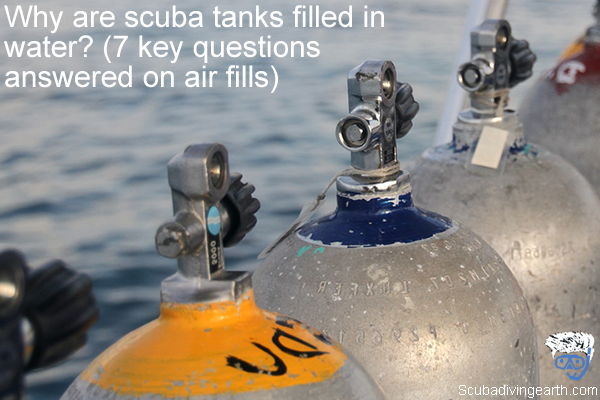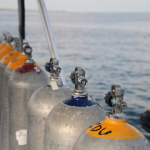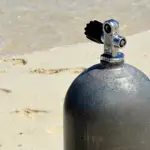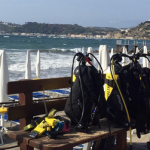
Why scuba cylinders are put into cold water when being filled with compressed air
If you didn’t already realise it, scuba tanks should always be filled with the tank immersed in cold water. But why are scuba tanks filled in water and what happens if they aren’t?
The reason why scuba tanks are filled in cold water is that a warm dive tank holds less air at a given pressure than a cool scuba tank does at the same pressure. This means that as the air inside the tank cools, the pressure of the air will decrease.
Which means by controlling the temperature of the dive tank during the filling process will increase the amount of air available when the tank is used on the next dive.
The best way to do more diving where scuba cylinders are provided as part of the dive package, is to book yourself on a scuba diving liveaboard. You can check the latest and best deals on liveaboards using the following window:
Why are scuba tanks filled in water?
To understand why scuba tanks are filled in water there are a number of concepts to grasp, which are as follows:
- How are scuba tanks filled with air?
- Why does air heat up when compressed?
- Why is it a problem that the compressed air inside the scuba tank warms up?
- Why does warm air expand?
- Why does air contract when cooled?
- Why are scuba tanks filled in water?
- What happens if scuba tanks are not filled in water?
Let’s now take a look at each of these questions in turn, which will help to answer the question why are scuba tanks filled in water.
1. How are scuba tanks filled with air?
There are two main methods used to fill scuba cylinders with air. The first method is to filled the scuba tank with compressed air using a high pressure breathing air compressor.
The alternative method is to fill scuba cylinders by decanting the air from high pressure storage cylinders instead.
It is during the process of compressing the air in this way that heats up the air, but why is that?
2. Why does air heat up when compressed?
When air is compressed, the air molecules move more rapidly, which has the effect of increasing the temperature. This phenomenon is called “heat of compression”.
The process of compressing air forces it into a smaller space, and as a result the molecules are brought closer to each other.
It is this process that causes the production of heat. This is particularly true where the process happens very rapidly. The faster the process of compressing the air, the warmer or hotter the air will get.
If you’ve ever touched a scuba tank that’s being filled with compressed air, you feel the warmth radiating from the tank.

3. Why is it a problem that the compressed air inside the scuba tank warms up?
The reason why it’s a problem that a scuba tank warms up during the filling process is that a warm tank holds less air at a given pressure than a cool tank does at the same pressure.
If a dive tank were to be filled to capacity whilst the air inside the tank is warm, the actual volume of air would not be as much as it could be once the air has cooled down.
As the compressed air inside the scuba tank cools down, the pressure of air inside will drop. The result would be an “under-filled” scuba tank.
4. Why does warm air expand?
The reason why warm air expands in this way is because the particles of air on becoming warm, move away from each other and take up more space.
So whilst the amount of air is the same, this same amount of air takes up more space or increases in volume.
Therefore, hot air occupies more space, which is as a result of the particles moving away from each other.
5. Why does air contract when cooled?
Therefore, the reverse is true of air when it cools down.
On the basis that hot air molecules occupy more space between them than cool air molecules do, it therefore follows that if you cool the air down, it will contract as the cool air molecules will need less space than hot air molecules.
6. Why are scuba tanks filled in water?
Finaly back to the main question of this article, which is why are scuba tanks filled in water?
On the basis that cool air takes up less space, it’s important to keep the scuba tank cool as the compressed air is pumped into the tank.
By keeping the dive cylinder cool on the outside, this in turn will help to keep the compressed air on the inside of the tank cool too, which is therefore less likely to expand.
Dive tanks are immersed in water on the basis that water is a great conductor of heat. The water around the dive tank takes the warmth away from the tank as it warms during the compression process.
Therefore by controlling the temperature of the dive tank in a water bath during the filling process, this will increase the amount of air available when the tank is used on the next dive.
7. What happens if scuba tanks are not filled in water?
If a scuba dive tank is filled with compressed air and not immersed in cold water, you’ll end up with a dive tank that is not filled to capacity. This is what’s known as a “short-fill of air“.
As discussed above, if the compressed air is warm it takes up more space. If the warm air takes up more space it will exert more pressure on the scuba dive tank.
All dive cylinders have a pressure limit to which they should not be taken over.
What happens when scuba tanks are filled, but not kept cool, is that when the air cools down the pressure drops and you’ll have disappointed divers who don’t have enough air to extend their dive time for their given dive.
More Reading: 28 Tips on How to Conserve Air While Scuba Diving (How To Extend Your Dive Time Safely)
I hope you enjoyed this article about why are scuba tanks filled in water
I’d love to hear from you. Tell us about your adventures of diving and snorkeling, in the comments below. Please also share your photos. Either from your underwater cameras or videos from your waterproof Gopro’s!
If this article hasn’t answered all of your questions. If you have more questions either about snorkeling or scuba diving (or specifically about why are scuba tanks filled in water), please comment below with your questions.
There will also be many more articles about scuba diving (and snorkeling) for you to read and learn about these fabulous sports.
Have fun and be safe!
More Reading: Do empty scuba tanks float? (This depends on the material they are made from)




